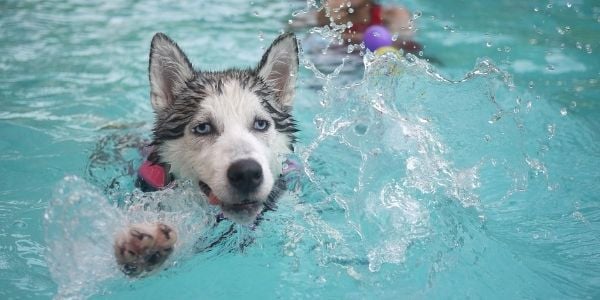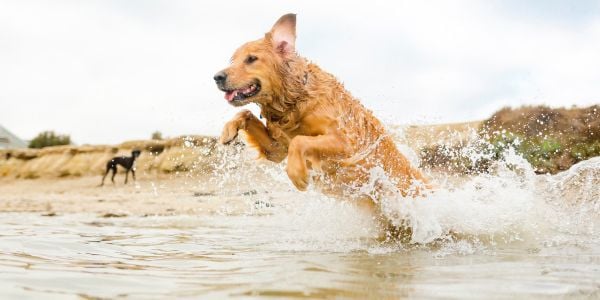
Swimming or playing in the water is a great form of exercise and entertainment for your dog.
And if you live near a body of water such as a pond, lake, river, or ocean (or are visiting one), the water can provide hours of fun for both of you.
While fun and exercise are important, so is being aware of all the dangers associated with ponds, lakes, rivers, and oceans.
Knowing what precautions you need to take is the best way to have fun safely as you and your pet enjoy a splash in the water. After all … knowing is half the battle!
Skip to section:
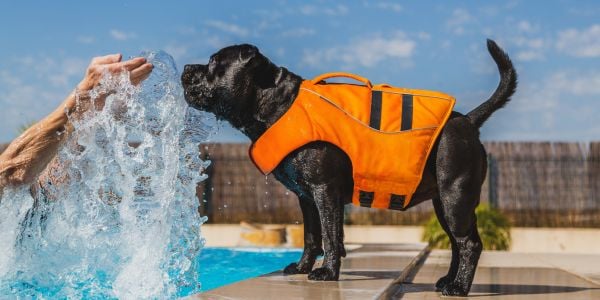
Drowning
While we may assume that all dogs are born knowing how to swim, that just isn’t the case. Every year, it is estimated that thousands of family pets drown. And it’s not just novice swimmers or those in rough oceans and lakes.
Drowning happens when a dog becomes completely submerged in water, and their lungs can’t get oxygen and stop functioning.
Almost all causes of drowning occur due to exhaustion.
Puppies and dogs with short muzzles and barrel chests (e.g., Bulldogs, Pugs) are generally more vulnerable to drowning. Additionally, dogs with cropped or short cork-screwed tails are lacking an effective rudder.
This can cause their hind end to sink and result in exhaustion from having to work harder to stay afloat.
How to Prevent Drowning
- ALWAYS supervise your dog, even if they are a professional swimmer, when they are near or in water.
- Anytime they are near water, including boating, have them wear a well-fitted lifejacket. Ruffwear makes a great float coat.
- Teach your dog how to swim – the younger, the better. Learn more about teaching your dog to swim.
- Skip tossing balls or sticks into water to avoid them getting water into their open mouth as they swim back. Especially important to prevent dry drowning (next section).
- Keep them on a leash when at the lake or near the ocean, especially if it is their first time or you are not able to properly monitor them. Be aware of the areas' posted leash rules.
- Be sure that you have taught your dog a reliable recall for when they are off-leash near water.
- If you take your pet boating, provide them with a way that they can easily enter the boat. Read more about boat safety and how to train your dog to go boating with you.
Pool Safety
I know this article is about the hazards in ponds, rivers, lakes, and oceans, but I feel it would be irresponsible of me not to mention something about avoiding drowning in pools.
- Pools should be fenced in
- Use a pool alarm system (this wireless alarm and this floating alarm that works with Alexa are two good options)
- Ensure your pet has an easy way to exit the pool. Install a pet-safe ramp, floating ramp, or ladder. Dogs need practice learning how to get in and out of a pool, so take the time to show them how and have them practice. If using a ladder, you can train them to use it the same way as a boat ladder.
- Even if your dog can swim, it's best they wear a life jacket when they have access to the pool
Warning about pool covers: Improperly secured or loose pool covers can create a serious drowning hazard. Pets view them as a solid surface, and they may attempt to walk on them. This could result in a serious tragedy. Even well-secured covers can be dangerous since water can collect on them. Your dog may get trapped on or under the cover, become exhausted from trying to escape, and then collapse in the water.
Learn CPR for dogs
Sadly, not all accidents can be prevented. If your dog will be spending time around any type of water, it is important you know CPR in case you find them unresponsive in the water. These resources can help you learn the basics that might just save your pet’s life. Read how Sparky was saved from drowning twice in one day.
Always have your dog evaluated by your veterinarian for any water injuries.
Dry Drowning
Dogs can suffer from “near-drowning” (a.k.a. “dry drowning”) as well.
Dry drowning occurs when water gets into your dog’s lungs or other parts of the airways while swimming, jumping in the water, or even playing in the bathtub. It can happen very quickly from merely swallowing a big gulp of water at once.
The ingested water can get "trapped" at the back of the throat and irritate the vocal cords, causing them to spasm. When this occurs, breathing becomes difficult. When the ingested water enters the lungs, serious complications and potentially death can occur.
It is important to know that dry drowning can also occur from swallowing sand.
Symptoms of Dry Drowning Include:
Dogs can show signs of dry drowning hours or even days after the water has entered the lungs.
- Coughing
- Wheezing
- Difficulty breathing
- Discomfort noted, especially around the chest area
- Lethargy, often extreme
- Bluish-colored gums and skin
- Anxiety
Seek veterinary care immediately if you suspect your dog is suffering from dry drowning. With prompt and appropriate treatment, most dogs have a good outcome. If left untreated, dry drowning can be life-threatening.
Water Intoxication
While it sounds crazy that a dog can suffer from the ingestion of too much water, it can happen. This condition is different from dry drowning, which is water going into the lungs. Water intoxication is drinking or taking in too much water into the stomach.
The condition occurs when a dog consumes a lot of water in a narrow window of time, and an electrolyte imbalance occurs within the cells.
The initial symptoms of water intoxication include vomiting, lethargy, and abdominal distention (a bloated belly). These can progress to include weakness, incoordination, seizures, coma, and death.
Treatment by a veterinarian needs to happen as soon as possible. Leaving a dog with water intoxication untreated can be very dangerous.
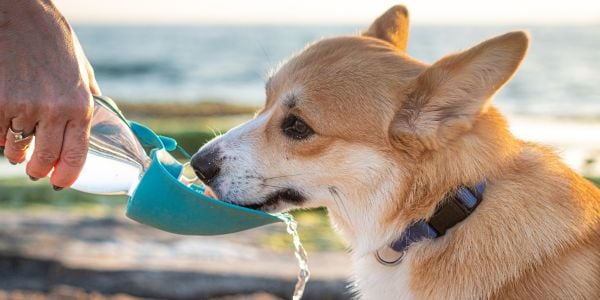
Saltwater Poisoning
If a dog consumes a significant amount of salt water, it can have harmful effects.
Dogs become quickly dehydrated when they consume too much salt water. To counteract the imbalance created by the excessive amount of salt in the body, cells within the body release water into the blood, which can cause dogs to be lethargic, dizzy, and act confused.
High levels of salt in the blood cause their muscles to stiffen from the loss of moisture, which can result in shaking or tremors.
Consumption of a small amount may just result in nausea, vomiting, and diarrhea. However, if they drink a significant amount, you may notice the following symptoms in addition to vomiting and diarrhea:
- Excessive thirst
- Excessive urination
- Lethargy
- Confusion
- Dizziness
- Muscle tremors or spasms
- Seizures
- Death
To prevent your dog from trying to rehydrate themselves with salt water when they are thirsty, be sure to bring an adequate amount of fresh water with you and have them drink at least a few sips about every 30 minutes.
If you know your dog consumed salt water, be sure to monitor them closely. Seek veterinary care if you notice any symptoms.
Water-borne Illnesses
Bodies of water, such as lakes and ponds, serve as a home for diseases. While some diseases are of little threat and easily treated, others can be devasting. Knowing about these diseases is the best way to protect your dog.
Common water-borne diseases include:
Leptospirosis
This disease is caused by a bacteria called Leptospira spp. It is present worldwide, and any mammal can be infected, including people. Dogs become infected by contact with contaminated water (especially stagnant or slow-moving), urine, or soil. The bacteria enters a dog’s body via ingestion, broken skin, or mucous membranes (eyes, nose, or mouth).
The good news is not all infected dogs get ill. The bad news is that it can cause organ damage and other complications, and severe cases can be fatal.
Symptoms of leptospirosis commonly seen include:
- Fever
- Lack of appetite
- Vomiting and diarrhea
- In some cases, dogs have been reported to have kidney and liver damage
Treatment involves antibiotic therapy. For cases that are more severe, hospitalization and supportive care are needed.
There is a Lepto vaccine to help prevent infections.

Giardiasis
Giardia spp. is a microscopic protozoan that causes giardiasis. The parasite can be found worldwide in lakes, ponds, streams, wells, pools, water parks, and spas.
Dogs become infected by eating or sniffing contaminated ground or drinking contaminated water.
The most common symptom is diarrhea. However, most infected dogs do not have diarrhea, vomiting, or other symptoms of illness. Puppies and debilitated adult dogs may develop severe cases that can be fatal if not treated.
Treatment typically involves dewormers, antibiotic therapy, and medications to control any other symptoms if present.
Pythiosis
This is a rare but serious and often fatal disease. It is caused by a type of fungus called Pythium insidiosum. This fungus can cause infections of the skin and intestinal tract. Immunocompromised dogs (e.g., dogs suffering from cancer, Lupus, or those on immunosuppressive medications) are at the greatest risk for the development of this disease.
Gulf Coast states are where it is most commonly seen, but it has been noted in several Northern, Midwestern, and Western states.
Dogs become infected by ingesting or swimming in contaminated water.
Symptoms include skin lesions that are ulcerated and non-healing, weight loss, vomiting, diarrhea, and bloody stool.
Lesions of the skin and intestinal tract are surgically removed if not too extensive. If surgery isn’t possible, oral anti-fungal medications can be tried. But it is often unsuccessful.
Water Temperature
When your dog is playing in the water, keep the water temperature in mind since they will tire out faster the colder the water is.
If your dog doesn’t have an off switch, make sure that you’re watching their energy levels and stop playing when your dog shows signs of exhaustion.
If your dog stays in water that is too cold for too long, they are at risk of hypothermia. Hypothermia occurs when your dog’s body temperature falls below its normal range (100 to 102.5 F).
Hypothermia results in decreased body-wide perfusion of blood (blood flow). Swimming requires your dog’s muscles to work hard.
When the muscle doesn’t receive adequate blood flow, it is deprived of oxygen, and metabolic wastes build up. As the muscle continues to tire, the risk of drowning increases.
Dangerous Water Dwellers
Besides you and your dog, there are other creatures in the water. Some of these inhabitants can be a potential hazard to your dog.
Potentially dangerous inhabitants in ponds, lakes, and rivers include snakes, leeches, snapping turtles, certain species of toads, snails, and alligators. Any one of them can cause your dog harm.
Be aware of the type of water inhabitants in your region. For example, Florida alligators seem fond of dogs, and there have been many attacks.
The ocean has its own dangerous inhabitants, and depending on where you live, some are worse than others.
Such potentially dangerous creatures that could be a hazard for your dog include certain types of jellyfish (e.g., box jellyfish), stingrays, certain species of fish (e.g., scorpionfish and lionfish), sea urchins, and one can’t forget sharks. And there are likely many more!
Also, be aware of the dead fish lying in the water or laying on the beach. Ingestion can cause a choking hazard and stomach upset.
Other non-living things that inhabit the water that could pose a hazard are sharp rocks and shells. These can easily cut your dog’s paw pads if they step on them or their mouth if they are so inclined to try and chew on them.

Harmful Algal Blooms
If you’re not yet familiar with harmful algal blooms (HABs) and your dog spends (or you yourself do) spend any time in lakes, rivers, or ponds, please take note of these and learn to recognize and avoid them.
HABs, like red tides and blue-green algae, can cause serious, debilitating, and even fatal problems for pets and people alike.
Red Tides
Red tides are overgrowths of particular types of algae that occur in oceans, bays, and estuaries that give the water a characteristic red color. These HABs can be extremely deadly and debilitating when they’re highly concentrated.
The toxins released can even be present in the air when a red tide is bad. Learn more about red tides.
Blue-Green Algae
Blue-green algae, or cyanobacteria overgrowths, often impart a blueish-green hue to affected water, but not always. They mostly occur in still water like lakes, reservoirs, ponds, and canals.
The toxins associated with blue-green algal overgrowths can cause everything ranging from mild skin irritation to severe liver failure. Learn more about blue-green algal overgrowths.
Here are some photos of blue-green algal blooms courtesy of the USEPA and Cyanobacteria Monitoring Collaborative.
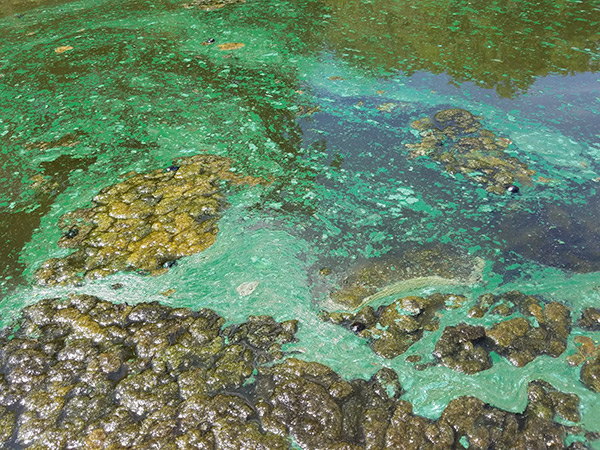
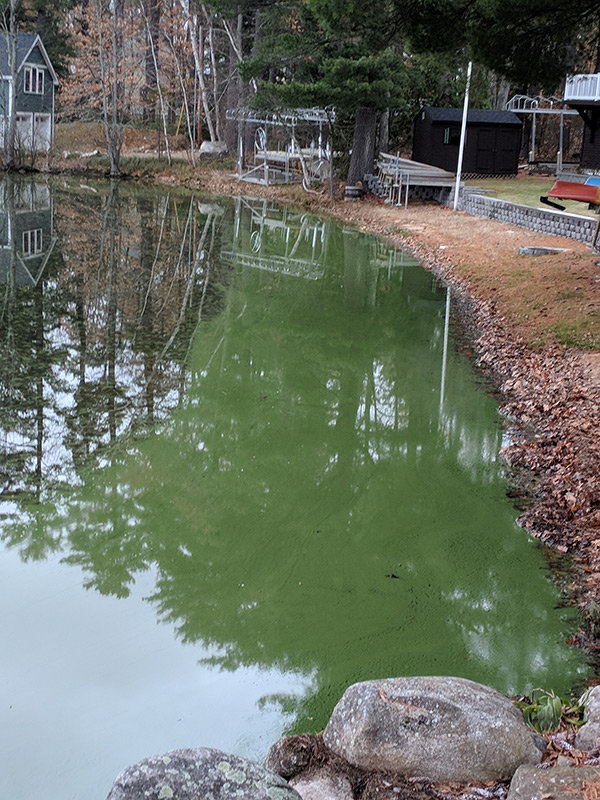
Symptoms of blue-green algae toxicity
Dogs that drink water containing blue-green algae or that groom the algae off their coat after swimming in such water can exhibit a range of signs, including:
- Uncoordinated walking (Ataxia)
- Drooling
- Vomiting
- Diarrhea
- Collapse
- Seizures
If you’re noticing these signs in your dog at any time, they need to be seen by a veterinarian right away. These are very serious signs indeed and may well indicate liver failure from blue-green algae exposure.
Blue-green algae affect people
Be aware these algae aren’t just a problem for your pets — they can cause illness in children and adults, too!
To find out if there are any blue-green algae warnings in your state, just google “blue-green algae (insert your state)” or check out these state-by-state resources: interactive map of state's blue-green algae labs and monitoring and state-by-state harmful algal bloom monitoring resources.
Using technology to combat blue-green algal blooms
Here's a great tool to help you and your pets (and other family members), as well as other people and their pets and families.
Check out and download the bloomWatch app (available for both iOS and Android) to learn more about blue-green algae and to help pet owners, scientists, and others find and monitor these dangerous blooms. Citizen science at its best and working for everyone!
You can also follow the social media feeds of CyanoTracker, a citizen science program out of the University of Georgia also focused on educating about, tracking, and combating blue-green algae.
Here's CyanoTracker on Twitter and CyanoTracker on Facebook.
Rip Currents
Rip currents (sometimes erroneously referred to as “rip tides”) are powerful and dangerous currents of water that run perpendicular to and away from shore. They have carried both pets and people out to sea, some with tragic results.
Contrary to what some people may believe, rip currents don’t just happen in the ocean. They can occur in any body of water with breaking waves – so not just oceans, but even larger lakes, like the Great Lakes.
Before letting your dog enter the water, study the flow and evaluate it for rip currents. Since warning signs aren’t always posted, be sure to learn how to recognize and escape rip currents. When in doubt, keep your pet out of the water.
Please know that dogs caught in rip currents often survive them just fine. Perhaps they have an innate knowledge of how to get out of them, or more likely, their strong swimming abilities or calmness and lack of panic let them ride it out and then return to shore.
What has sadly happened on more than a few occasions, though, is that a person jumps in to try and save them from the rip current, only succumbing to the rip current themselves while their dog rides it out and calmly exits.

Fishing Gear
If your dog is swimming while you or anyone else around you is fishing, take precautions to help ensure that the “catch of the day” isn’t your dog!
Plenty of dogs wind up at the vet with fishing hooks embedded in their nose, lip. or tongue, and it’s also not rare to see a dog that’s swallowed, well … hook, line, and sinker. So keep your dogs away from your or anyone else’s tackle box and whatever is hauled in.
Speaking about sinkers … if you’ve got any lead sinkers lying around and they often are left on the banks of the water, you’ll want to be extra careful of those, as they can cause lead poisoning should your dog be mischievous enough to swallow one (or several).
Since we don’t have eyes in the back of our heads, it is possible to miss your dog ingesting a lead sinker. Therefore, you should know the symptoms of lead poisoning. Symptoms include:
- Lethargy
- Frothing at the mouth
- Lack of appetite
- Weight loss
- Vomiting
- Diarrhea
- Seizures
- Behavioral changes
- Aggression
- Constant snapping
- Hysteria
- Hiding
- Depression
If you think there is even a slight possibility your dog consumed a lead sinker, it is always better to play it safe and take them to their veterinarian.
Salmon Poisoning Disease
Speaking of fish, if your dog is playing in or around the salmon-containing waters of the Pacific Northwest of the US (Washington, Oregon, northern California) or in British Columbia, Canada (southern Vancouver Island), you’ll want to keep a close eye and prevent them from gobbling up any salmon that may have found their way onto the shores.
This is because salmon, and other salmonid fish (incl. trout, char, and others), in these parts of North America, can contain a parasitic fluke (a kind of a worm) called Nanophyetus salmicola. This fluke is generally harmless to dogs.
However, if the fluke is infected with a bacteria called Neorickettsia helminthoeca and your dog ingests raw or undercooked salmon*, it can cause a condition in dogs (not-very-creatively) called salmon poisoning disease (SPD).
*Proper cooking of the fish kills the causative bacteria and fluke; it’s only raw (or undercooked – cook till the salmon temperature is 145 F per USDA recommendations) salmon that will cause salmon poisoning disease.
SPD only affects dogs and other canids (wolves, coyotes, etc.) SPD does not appear to affect cats or people. However, people may develop mild gastrointestinal symptoms. Learn more about salmon poisoning disease.
Dogs with SPD can develop the following symptoms within a week of ingestion:
- Fever
- Weakness
- Enlarged lymph nodes
- Discharge from their eyes or nose
- Elevated respiratory rate
- 10 to 30 breaths per minute
- Panting normally can be up to 200 pants per minute
- Elevated heart rate
- Normal heart rate for puppies and small dogs: 120 to 160 beats per minute
- Dogs greater than 30 lbs: 60 to 120 beats per minute
- Muscle tremors
- Seizures
- Debilitating diarrhea and vomiting
The main aspects of treatment include antibiotics to treat the bacterial infection and medications to kill the fluke.
While some dogs with SPD can be treated conservatively on an “outpatient basis” (i.e., don’t have to be admitted to the hospital), those with severe diarrhea and vomiting that prevents them from holding down food, water, and oral medications need to be admitted to the animal ER for effective treatment.
Treatment for dogs with severe signs includes intravenous fluids, medications to control vomiting and diarrhea, as well as antibiotics, and a dewormer. Blood transfusions are needed in some cases.
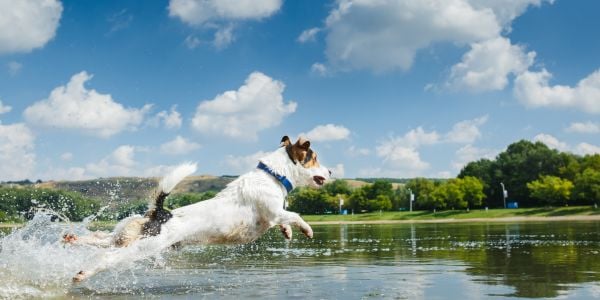
As a final note, I should mention a post-hazard of spending time in the water, don’t forget to clean your dog’s ears with an ear cleaner with drying agents so they don’t get an ear infection.
Water activities are a fun way for your dog to get great exercise, enrichment, and socialization, especially in the warm summer months. Now that you’re aware of the most common things to look out for when your dog is enjoying the water, you and your dog can enjoy hours of fun outdoors.



